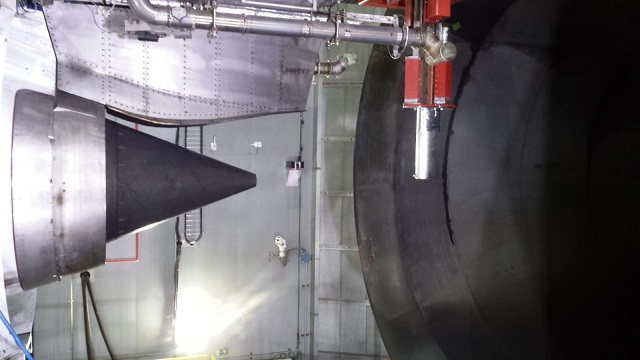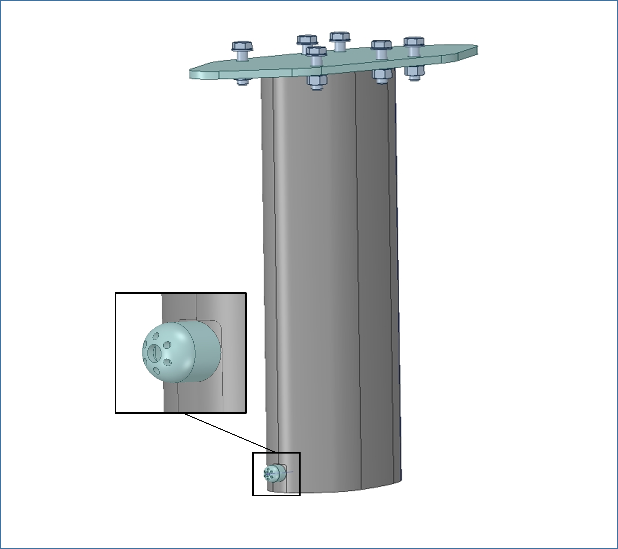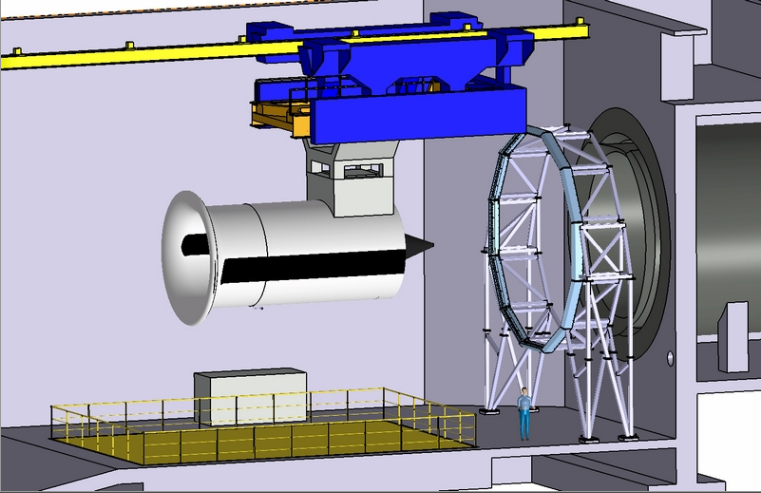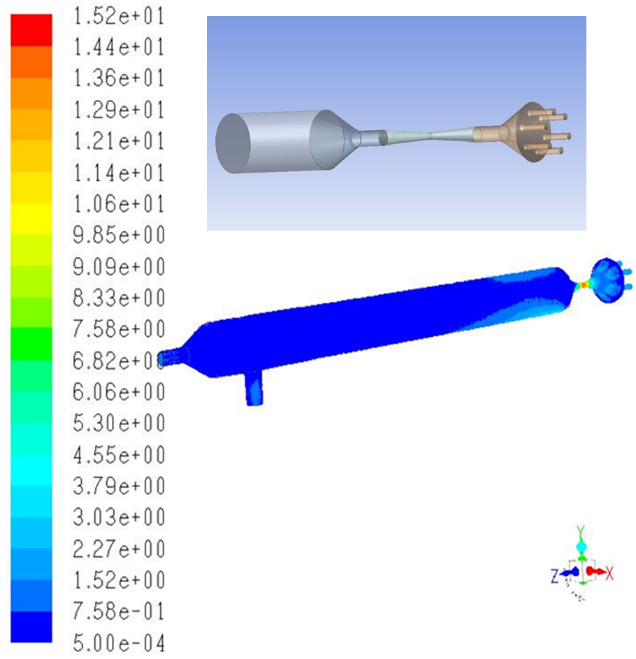Facilities
The main source of engine emissions is the combustion chamber, due to the fuel combustion. The exhaust gases generated in this combustion process leave the engine core as primary flow.
The evaluation and characterisation of these combustion emissions are carried out at two different planes at INTA:
- Measurement at the engine exit plane.
- Measurement downstream at the exhaust stack.
Intrusive measurements at INTA’s test-cell: ETP (Emissions Traverse Probe)
A sampling probe named ETP has been designed and installed at the INTA’s test-cell. This ETP is an extractive sampling system which is placed 2-3m behind the engine exhaust plane where the operating conditions are extreme (T> 500 °C and v> 300 m/s). These measurements are of special interest since they follow the AIR6241 standards for future aircraft emission regulation. Furthermore, they will also allow to improve the combustion chamber design by the engine manufacturers in order to optimise the engine combustion process.
The sample collected by the ETP is transferred to the Emission Room where the measurement instruments are located. The transfer section is constituted by a 25m heated hose at 160 °C with the aim of avoid the condensation of volatile compounds. At this sampling point, measurements of non-volatile Particulate Matter (nvPM) number and mass concentration are taken. CO2 concentration is measured as well, in order to study and corroborate the dilution factor.

Exhaust Stack measurements
A multi-point sampling probe is installed 55m downstream from the engine exit plane at the exhaust stack. The engine combustion gases pass through a telescopic tube called augmentor until they reach the exhaust stack, where the sample is already cooled up to around 40 °C and physical and chemical processes of the aerosol have taken place. At this sampling point, both mass and number concentration of nvPM and total PM are taken as an online measurement system. In addition, Polycyclic Aromatic Hydrocarbons (PAHs) concentration is determined by filtration as an off-line measurement system. The results obtained from these measurements will provide an enhanced understanding of aircraft emitted pollutants, and the scalability between the regulatory test-cell and real-world environments which will allow an assessment of their impact on air quality.
nbsp;
Non-Intrusive cell measurements: Optical Ring and LII
INTA also supports and encourages the development of scientific and technological infrastructures, including novel non-intrusive emission measurement methods and techniques. In this context, INTA and CIEMAT have developed a dodecagonal structure where different optical sensors are placed, allowing the development and testing of new technologies that characterise the turbofan engine exhaust emissions in a non-intrusive way. INTA has developed this structure as a partner in the FLITES project (Fibre-Laser Imaging of Gas Turbine Exhaust Species).
Oil Breather emission measurements
A continuous flow of high-pressure air compressed is required inside the engine in order to maintain the joints sealed. A small amount of this air is contaminated by oil leaks from the lubrication oil and thus it has to be cleaned by a separation system to remove the oil content. Part of this air is expelled to the outside by the engine’s vent system, while the recovered oil is integrated back into the engine. This engine lubrication oil emitted from the turbofan vent system can be an important emission contribution of semi-volatile hydrocarbon mass, which does not have to do with the combustion process. INTA is able to characterise this emission in its test-cell.
Cabin Bleed emission measurements
Some of the fresh ambient air from inside the engine compressor before the combustor is used as the pressurised ambient air source for the aircraft cabin (cabin air). INTA has developed the capability to characterise this air and proven that it meets the contaminant requirements from the engine.
Simulations
CFDs simulations, mainly with ANSYS/FLUENT, are carried out by the Instrumentation and Experimental measurement techniques Laboratory in order to validate the design of the different structures developed in the Department. This allow to study the viability of each design as well as to implement improvements, being a continuous development process.
Resources
ETP (Emissions Traverse Probe)
In order to characterise the main aircraft emission source following the future regulation AIR6241, a 750 mm vertically movable probe, named Emission Traverse probe (ETP), has been designed and installed at the engine exit plane where the operating conditions are severe and hazardous (reverberant environment and harsh profiles of vibroacoustics, temperature, pressure, velocity and flow). 316L stainless steel was chosen for the ETP, taking into account the design requirements and the simulation outcomes.
This ETP has been developed by INTA and CIEMAT with partial EU funding as part of the project Development of a Public European Environmental Model Suite for Aviation. There has been developed and tested some different prototypes of this probe in several experimental measurement campaigns and with different RR engines (TRENT1000 & TRENT900 families), obtaining a satisfactory response.
CFD simulations of the response of possible improvements are being studied, constituting a resource in continuous development.

Optical ring
INTA and CIEMAT have developed a novel structure for the non-intrusive measurement of CO2 at the engine exit plane.
A 7m diameter (10m tall and 12 m sided frame) optical ring has been installed in the INTA’s test-cell. It is formed by numerous infrared lasers (launch and receive units), which define six optical projections. This structure provides a measurement of path-integrated CO2 concentration across the exhaust, allowing tomographic imaging of its distribution. These CO2 distributions can then be used in obtaining Soot Emission Index.

LII
The incomplete combustion of fuel Jet-A1 produces soot particles (dry solid particles), which are then emitted in aircraft engine exhaust. Soot is considered one of the most dangerous and harmful pollutants, having adverse effects on air quality and, consequently, on human health.
The Laser-Induced Incandescence (LII) allow to quantify the soot mass concentration, which corresponds to the nvPM fraction. This is an optical technique that involves measuring the thermal emission (incandescent light) emitted from particles heated by a pulsed laser to temperatures in the 2500 K to 4500 k range. At this temperature, all volatile components that may have been condensed on the soot particles will be promptly evaporated.
Multi-Orifice Probe
INTA and CIEMAT have developed and installed a multi-orifice probe 55m downstream from the engine exit plane, in the exhaust stack.
This 14m longitudinal probe consist on six sampling points at different distances in order to get representative samples under the different engine operating conditions. The separation distances of the sampling points has been defined assessing the deposition losses corresponding to the transport line of each one. In addition, this multi-orifice probe is provided by a homogenisation chamber in which the sample extracted from each sampling point is mixed, in order to get a homogenous and laminar sample flow.

Aircraft emission sampling points
Currently, the Instrumentation and Experimental measurement techniques Laboratory takes turbo-engine emission measurements at different sampling points:
- Engine exit plane
- Exhaust stack
- Breather
- Cabin Bleed
